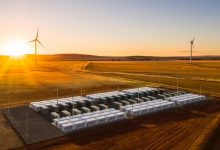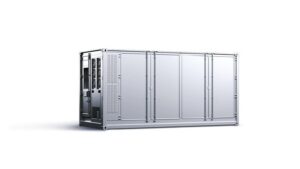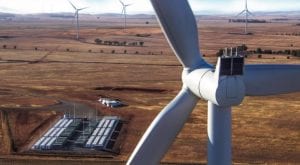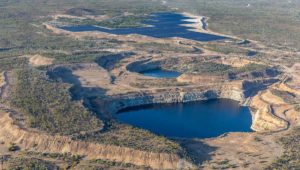They say that lightning never strikes twice. But on August 25 last year a single lightning strike managed to take out two major circuits on the main transmission line linking NSW and Queensland.
The impact was almost immediate, and felt across Australia’s main grid. It caused load-shedding at a scale that made the much-talked about load shedding in Victoria in January’s heat wave look comparatively small beer.
We reported the events at the time, noting the irony of the Tesla big battery holding together the grid on the very first full day of work for the new prime minister, Scott Morrison, the man who had spent so much time promoting coal and ridiculing new technologies like the big battery.
Our initial report has now been underscored by a detailed study from the Australian Energy Market Operator, which looked at why more than 1,190MW of load was shed in three states, why Queensland operated for nearly an hour and a half in an insecure state that could have gone pear-shaped very quickly, and why renewables-dominated South Australia had the most secure grid during the events.
The report underlines a few important points.
One, is that the Tesla big battery, again, proved itself to be an exceptionally valuable asset in the face of such events.
It was the quickest to respond and showed a versatility un-matched by any other asset, and its efforts ensured that South Australia’s was the only state grid not to suffer widespread losses or operate in an insecure state, despite its high share of renewables.
Point two is that Australia’s ageing and slow-moving legacy assets reacted poorly, and it is increasingly clear that they are going to create headaches for the market operator as it manages the energy transition, and seeks to perform the energy equivalent of the shift from analogue to digital.
Three: new technologies such as wind farms and rooftop solar inverters are also throwing curve balls, with unexpected responses to different situations.
And four; the market operator and the rule-maker need to act quickly and decisively to bring in rules that are useful to the latest technology, and not those of the last century.
So what happened on August 25?
It was a Saturday, and just after 1.11pm, when lightning struck and took out the two circuits of the main inter-connector between NSW and Queensland, and within two seconds the Queensland grid was islanded.
Frequency plunged in the rest of the grid and almost immediately more than 900MW of smelter load (two pot lines at Alcoa and one at Tomago) was lost in Victoria and NSW, as well as another 93MW of consumer load in both states.
Another 80MW of industrial load was lost in Tasmania. Within a few more seconds, South Australia also disconnected as a result of the events, but suffered no ill effects.
According to AEMO, South Australia largely has the Tesla big battery – owned and operated by Neoen at Hornsdale – to thank for that; yet another validation of the technology that is causing a major re-think about the way we should manage the grid.
“The large-scale battery storage in SA was valuable in this event, assisting in containing the initial decline in system frequency, and then rapidly changing output from generation back to load, to limit the over-frequency condition in SA following separation from (Victoria),” the report notes.
AEMO’s assessment of other technologies is not so glowing, and its report underscores the serious concerns about the state of thermal generation (coal and gas), which it says did not respond to the incidents as hoped.
- “Many (coal and gas) generators either no longer automatically adjust output in response to local changes in frequency or only respond when frequency is outside a wider band (dead-band) than has historically been set,” it notes.
- “This lack of response resulted in significant technical challenges controlling power system frequency during this event, delaying the resynchronisation of QLD with NSW.”
The report noted two trips of generators in Queensland, one a “baseload” gas plant and another a small hydro facility, and dangerous and troubling oscillations at both the Liddell and Bayswater coal generators in NSW, which reacted poorly to the frequency excursions.
Even more troubling, the report notes that the Queensland grid, for all its gigawatts of coal and gas plants, operated in an insecure state for nearly 90 minutes, because none of the coal and gas units could provide primary frequency control, which meant it had no protection in the case of any of its large units falling over.
The report also unearths issues with wind and solar. Another software issue was detected in four South Australia wind farms, although on this occasion it worked in the grid’s favour because, as their output of 80MW wound down to zero, that helped address the over-frequency. That issue has now been solved.
More perplexing, AEMO also uncovered ongoing issues with some rooftop solar inverters, despite new standards introduced in 2016. In fact, in South Australia, the failure rate of the new inverters was double the rate of those installed before the 2016 change in standards. That issue has not yet been resolved.
But it is the speed and accuracy of the response of the Tesla big battery that emerges as the highlight of the AEMO report. The battery has been repeatedly lampooned by the government and other critics for its failure to deliver power for extended periods as a peaking power plant. But that’s not its primary purpose, and its value to the grid lies elsewhere.
Within hours of South Australia’s state-wide blackout in September 2016, promoters and developers were declaring that an array of small batteries, or even a big battery or two, could have held the grid together and minimized the outages.
That boast was repeated some months later by Tesla chief technology officers JB Straubel which in turn led to the so-called “billonaire tweets” between musk and Australia’s Mike Cannon Brookes, and eventually the construction of the Tesla big battery next to the Hornsdale wind farm – in less than 100 days .
We will never know whether the battery or any other technology would have been enough to withstand the catastrophic sequence of the events in South Australia in September, 2016, but the event last August put the battery to its sternest test yet.
What we do know now is that it appears to be able to deliver exactly what the battery boosters said it would – it kept the lights on in South Australia while other states reliant on older fossil fuel technologies suffered wide-spread outages.
 It’s ironic that this should be the case, because most of the grid was running on coal and gas – (96 per cent according to AEMO, plus around 10 per cent from rooftop solar). South Australia was split around 50-50 – with just her 800MW of gas, 210MW of large-scale wind and solar, and another 600MW of rooftop PV.
It’s ironic that this should be the case, because most of the grid was running on coal and gas – (96 per cent according to AEMO, plus around 10 per cent from rooftop solar). South Australia was split around 50-50 – with just her 800MW of gas, 210MW of large-scale wind and solar, and another 600MW of rooftop PV.
As AEMO notes, The Tesla battery at Hornsdale (officially known as the Hornsdale Power Reserve) did exactly what it was supposed to do.
It was charging at -38 MW immediately prior to the event, before instantly switching to discharging (up to 44MW) as frequency fell across the grid after the Queensland line separated, and then a few seconds later switching back (in the blink of an eye) to charging (down to -62MW) to help address the frequency surge following the South Australia link failing.
“This response is consistent with the design,” AEMO notes. “It contributed to both arresting the initial decline in system frequency, and then by rapidly changing output from generation back to load, to arrest the over-frequency condition in SA following separation from VIC.
“Only active power response delivered prior to the minimum or maximum frequency condition in an event such as this contributes to arresting the change in frequency.
“The very rapid speed of delivery of frequency response from the Hornsdale battery was valuable in this event, and ensured the response contributed to limiting the under- and over-frequency conditions.”
In contrast, the response to the frequency excursions from the gas plants in the state was poor, with “little corresponding short-term movement in the output of synchronous generation to correct frequency” and only a “slow and limited response to system frequency.”
As a whole, AEMO is particularly concerned that the degradation of frequency response from the big thermal generators over the last decade means that the system now relies on industrial and consumer loads being switched off when such events occur. This was not always the case.
“Initial frequency response from some generation was delayed to the point where it was of no benefit in containing the rapid changes in frequency that immediately follow a major power system event like regional separation,” it notes.
“The speed of frequency control response from these generators must be improved where possible, for it to be effective in containing the critical initial deviation.”
This lack of response resulted in significant technical challenges controlling power system frequency during this event, delaying the resynchronisation of QLD with NSW.
AEMO is particularly concerned that the degradation of frequency response from the big thermal generators over the last decade means that the system now relies on industrial and consumer loads being switched off when such events occur.
This event indicates that the resulting decrease in primary frequency control has significantly reduced the ability of the power system to arrest the impact of non-credible contingency events in time to avoid the risk of cascading failures. caused by widening dead band setting.
It has a long list of things to do. This includes looking at whether some of the coal and gas plants in Queensland could provide FCAS, investigating the control settings for inter-connectors which it fears are no longer appropriate, and get to the bottom of the rooftop solar inverters, and make sure they can be an asset rather than a liability in such circumstances.











